Comprehensive Study: Causes and Factors in Buddhism's Decline in India
VerifiedAdded on 2023/04/05
|6
|1213
|423
Essay
AI Summary
This essay provides a comprehensive analysis of the decline of Buddhism in India, exploring the multifaceted factors that contributed to its diminishing influence. It examines the impact of regionalization following the Gupta Empire's end, the loss of royal patronage to Hinduism, and the influence of invading groups like the Huns and Persians. Internal corruption within Buddhist Sanghas, the shift towards luxury among monks, and the adoption of complex rituals are also addressed. The essay highlights the resurgence of Hinduism, which re-organized itself by accepting Buddha as an incarnation and adopting non-violence, ultimately diminishing Buddhism's appeal. Furthermore, it discusses the divisions within Buddhism, the shift to Sanskrit, and the rise of Brahmanical faith under rulers like Pushyamitra Sunga. The absence of influential leaders and the rise of image worship are identified as further contributing factors. The essay concludes by emphasizing the critical role of royal patronage and the eventual loss of it, which significantly impacted Buddhism's ability to thrive. Overall, the essay provides a detailed historical overview of the decline of Buddhism in India.
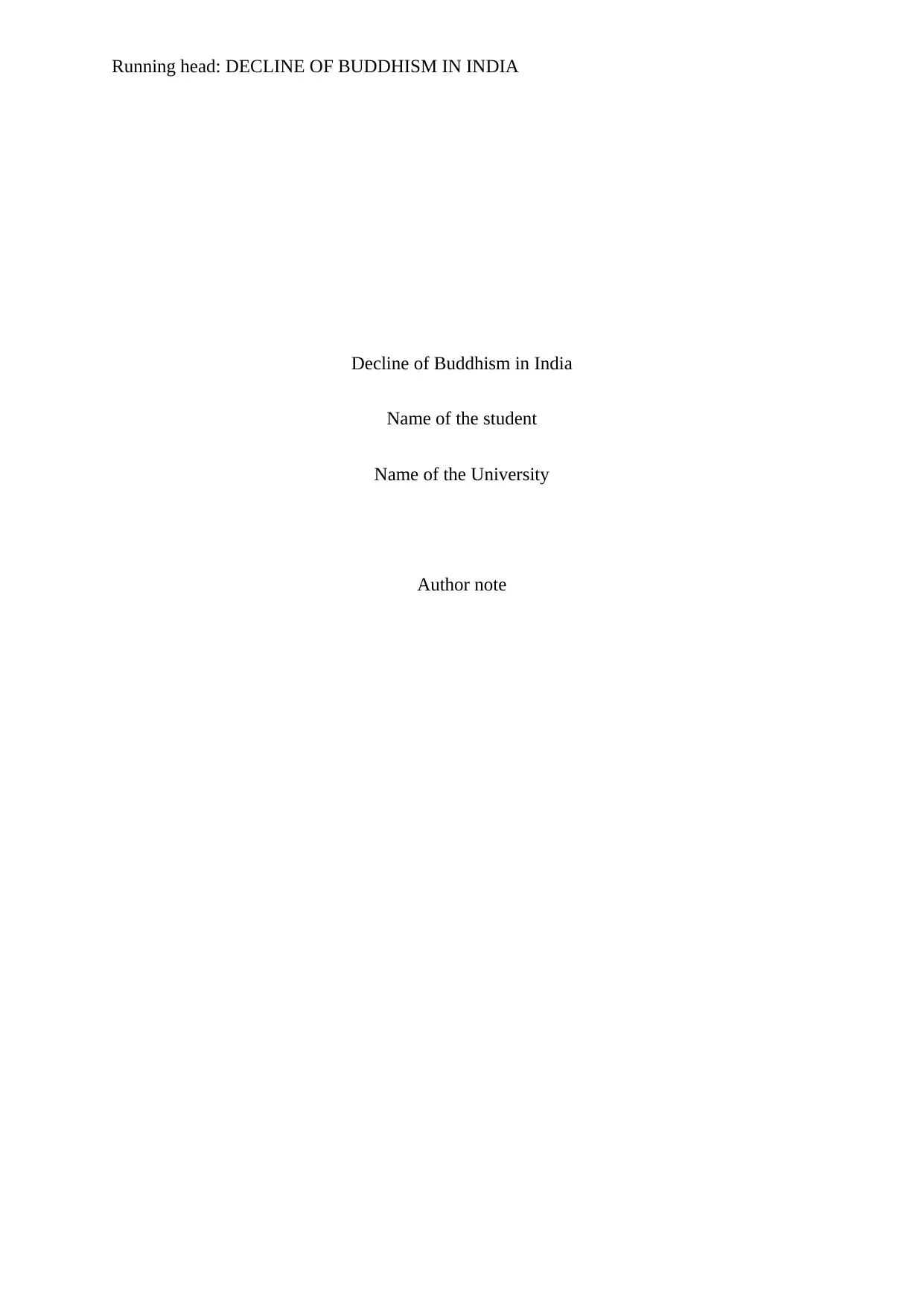
Running head: DECLINE OF BUDDHISM IN INDIA
Decline of Buddhism in India
Name of the student
Name of the University
Author note
Decline of Buddhism in India
Name of the student
Name of the University
Author note
Paraphrase This Document
Need a fresh take? Get an instant paraphrase of this document with our AI Paraphraser
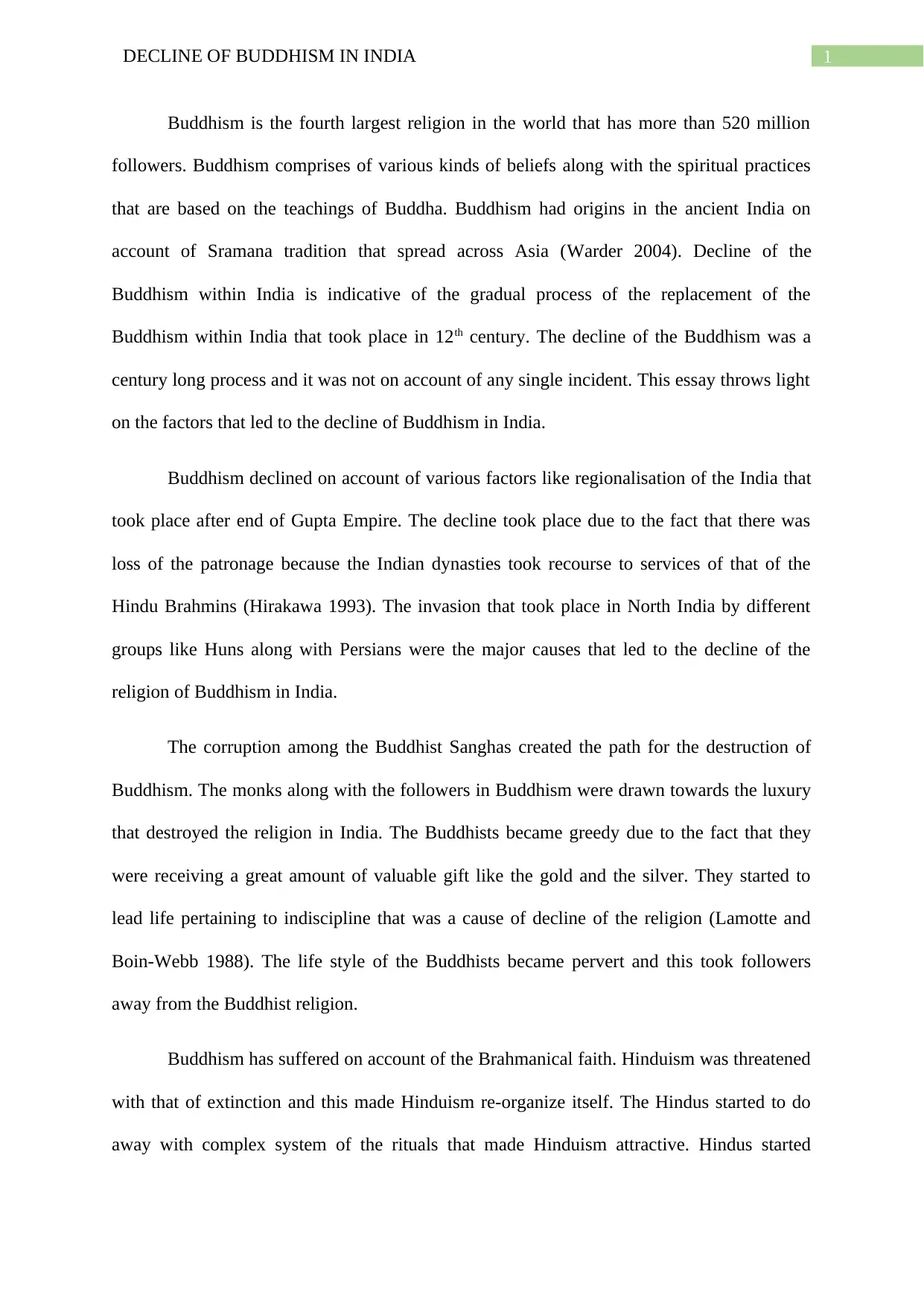
1DECLINE OF BUDDHISM IN INDIA
Buddhism is the fourth largest religion in the world that has more than 520 million
followers. Buddhism comprises of various kinds of beliefs along with the spiritual practices
that are based on the teachings of Buddha. Buddhism had origins in the ancient India on
account of Sramana tradition that spread across Asia (Warder 2004). Decline of the
Buddhism within India is indicative of the gradual process of the replacement of the
Buddhism within India that took place in 12th century. The decline of the Buddhism was a
century long process and it was not on account of any single incident. This essay throws light
on the factors that led to the decline of Buddhism in India.
Buddhism declined on account of various factors like regionalisation of the India that
took place after end of Gupta Empire. The decline took place due to the fact that there was
loss of the patronage because the Indian dynasties took recourse to services of that of the
Hindu Brahmins (Hirakawa 1993). The invasion that took place in North India by different
groups like Huns along with Persians were the major causes that led to the decline of the
religion of Buddhism in India.
The corruption among the Buddhist Sanghas created the path for the destruction of
Buddhism. The monks along with the followers in Buddhism were drawn towards the luxury
that destroyed the religion in India. The Buddhists became greedy due to the fact that they
were receiving a great amount of valuable gift like the gold and the silver. They started to
lead life pertaining to indiscipline that was a cause of decline of the religion (Lamotte and
Boin-Webb 1988). The life style of the Buddhists became pervert and this took followers
away from the Buddhist religion.
Buddhism has suffered on account of the Brahmanical faith. Hinduism was threatened
with that of extinction and this made Hinduism re-organize itself. The Hindus started to do
away with complex system of the rituals that made Hinduism attractive. Hindus started
Buddhism is the fourth largest religion in the world that has more than 520 million
followers. Buddhism comprises of various kinds of beliefs along with the spiritual practices
that are based on the teachings of Buddha. Buddhism had origins in the ancient India on
account of Sramana tradition that spread across Asia (Warder 2004). Decline of the
Buddhism within India is indicative of the gradual process of the replacement of the
Buddhism within India that took place in 12th century. The decline of the Buddhism was a
century long process and it was not on account of any single incident. This essay throws light
on the factors that led to the decline of Buddhism in India.
Buddhism declined on account of various factors like regionalisation of the India that
took place after end of Gupta Empire. The decline took place due to the fact that there was
loss of the patronage because the Indian dynasties took recourse to services of that of the
Hindu Brahmins (Hirakawa 1993). The invasion that took place in North India by different
groups like Huns along with Persians were the major causes that led to the decline of the
religion of Buddhism in India.
The corruption among the Buddhist Sanghas created the path for the destruction of
Buddhism. The monks along with the followers in Buddhism were drawn towards the luxury
that destroyed the religion in India. The Buddhists became greedy due to the fact that they
were receiving a great amount of valuable gift like the gold and the silver. They started to
lead life pertaining to indiscipline that was a cause of decline of the religion (Lamotte and
Boin-Webb 1988). The life style of the Buddhists became pervert and this took followers
away from the Buddhist religion.
Buddhism has suffered on account of the Brahmanical faith. Hinduism was threatened
with that of extinction and this made Hinduism re-organize itself. The Hindus started to do
away with complex system of the rituals that made Hinduism attractive. Hindus started
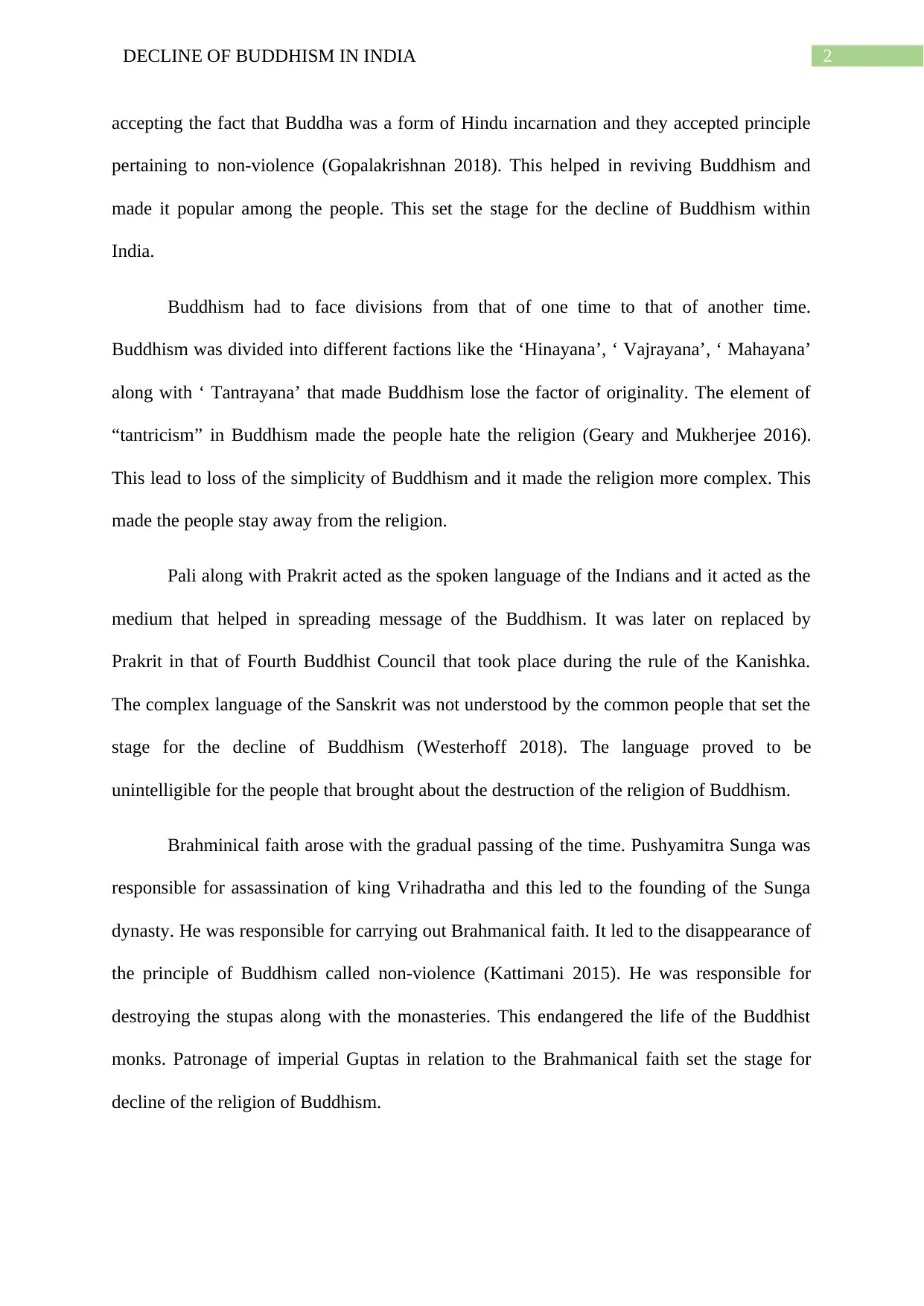
2DECLINE OF BUDDHISM IN INDIA
accepting the fact that Buddha was a form of Hindu incarnation and they accepted principle
pertaining to non-violence (Gopalakrishnan 2018). This helped in reviving Buddhism and
made it popular among the people. This set the stage for the decline of Buddhism within
India.
Buddhism had to face divisions from that of one time to that of another time.
Buddhism was divided into different factions like the ‘Hinayana’, ‘ Vajrayana’, ‘ Mahayana’
along with ‘ Tantrayana’ that made Buddhism lose the factor of originality. The element of
“tantricism” in Buddhism made the people hate the religion (Geary and Mukherjee 2016).
This lead to loss of the simplicity of Buddhism and it made the religion more complex. This
made the people stay away from the religion.
Pali along with Prakrit acted as the spoken language of the Indians and it acted as the
medium that helped in spreading message of the Buddhism. It was later on replaced by
Prakrit in that of Fourth Buddhist Council that took place during the rule of the Kanishka.
The complex language of the Sanskrit was not understood by the common people that set the
stage for the decline of Buddhism (Westerhoff 2018). The language proved to be
unintelligible for the people that brought about the destruction of the religion of Buddhism.
Brahminical faith arose with the gradual passing of the time. Pushyamitra Sunga was
responsible for assassination of king Vrihadratha and this led to the founding of the Sunga
dynasty. He was responsible for carrying out Brahmanical faith. It led to the disappearance of
the principle of Buddhism called non-violence (Kattimani 2015). He was responsible for
destroying the stupas along with the monasteries. This endangered the life of the Buddhist
monks. Patronage of imperial Guptas in relation to the Brahmanical faith set the stage for
decline of the religion of Buddhism.
accepting the fact that Buddha was a form of Hindu incarnation and they accepted principle
pertaining to non-violence (Gopalakrishnan 2018). This helped in reviving Buddhism and
made it popular among the people. This set the stage for the decline of Buddhism within
India.
Buddhism had to face divisions from that of one time to that of another time.
Buddhism was divided into different factions like the ‘Hinayana’, ‘ Vajrayana’, ‘ Mahayana’
along with ‘ Tantrayana’ that made Buddhism lose the factor of originality. The element of
“tantricism” in Buddhism made the people hate the religion (Geary and Mukherjee 2016).
This lead to loss of the simplicity of Buddhism and it made the religion more complex. This
made the people stay away from the religion.
Pali along with Prakrit acted as the spoken language of the Indians and it acted as the
medium that helped in spreading message of the Buddhism. It was later on replaced by
Prakrit in that of Fourth Buddhist Council that took place during the rule of the Kanishka.
The complex language of the Sanskrit was not understood by the common people that set the
stage for the decline of Buddhism (Westerhoff 2018). The language proved to be
unintelligible for the people that brought about the destruction of the religion of Buddhism.
Brahminical faith arose with the gradual passing of the time. Pushyamitra Sunga was
responsible for assassination of king Vrihadratha and this led to the founding of the Sunga
dynasty. He was responsible for carrying out Brahmanical faith. It led to the disappearance of
the principle of Buddhism called non-violence (Kattimani 2015). He was responsible for
destroying the stupas along with the monasteries. This endangered the life of the Buddhist
monks. Patronage of imperial Guptas in relation to the Brahmanical faith set the stage for
decline of the religion of Buddhism.
⊘ This is a preview!⊘
Do you want full access?
Subscribe today to unlock all pages.

Trusted by 1+ million students worldwide
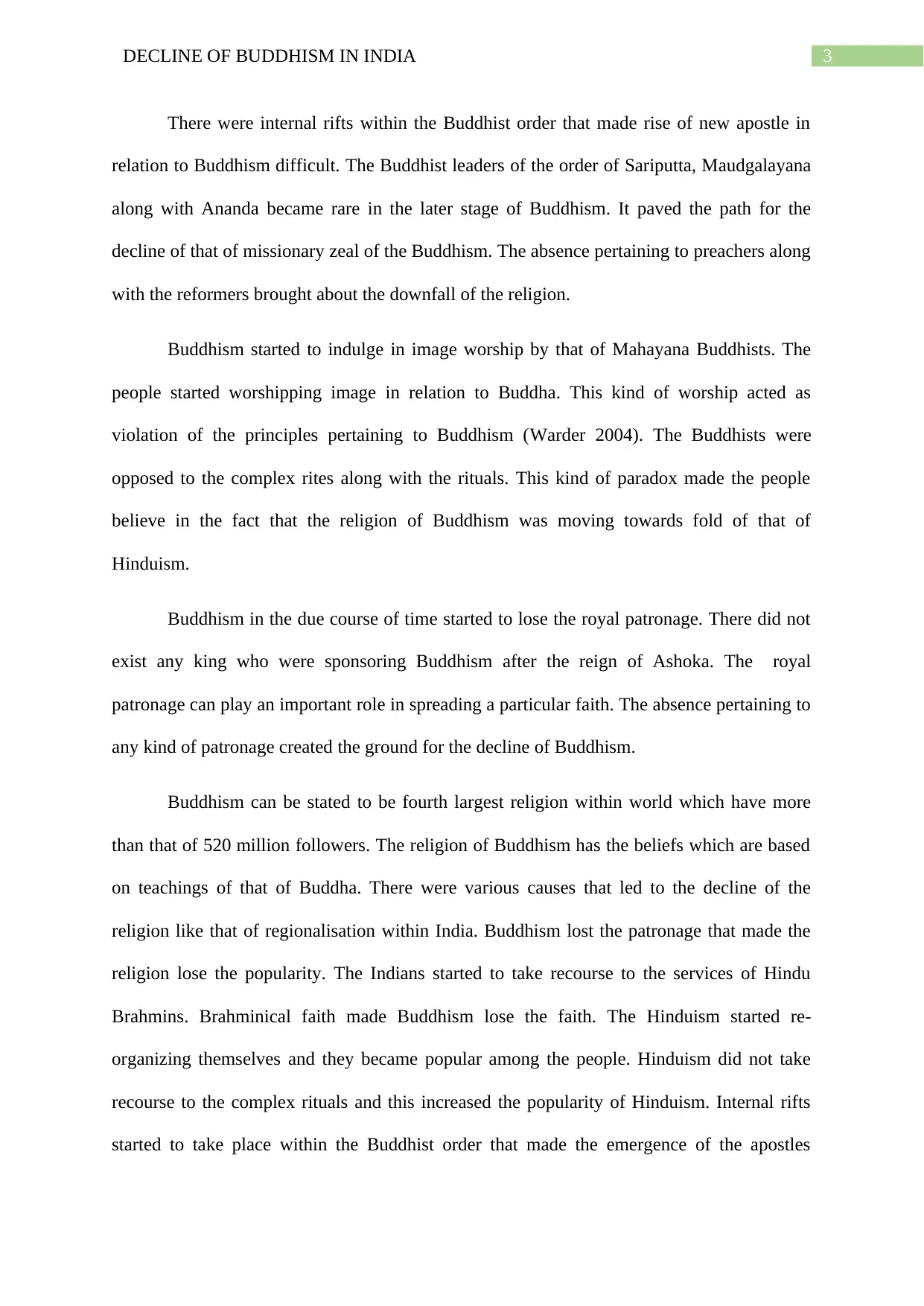
3DECLINE OF BUDDHISM IN INDIA
There were internal rifts within the Buddhist order that made rise of new apostle in
relation to Buddhism difficult. The Buddhist leaders of the order of Sariputta, Maudgalayana
along with Ananda became rare in the later stage of Buddhism. It paved the path for the
decline of that of missionary zeal of the Buddhism. The absence pertaining to preachers along
with the reformers brought about the downfall of the religion.
Buddhism started to indulge in image worship by that of Mahayana Buddhists. The
people started worshipping image in relation to Buddha. This kind of worship acted as
violation of the principles pertaining to Buddhism (Warder 2004). The Buddhists were
opposed to the complex rites along with the rituals. This kind of paradox made the people
believe in the fact that the religion of Buddhism was moving towards fold of that of
Hinduism.
Buddhism in the due course of time started to lose the royal patronage. There did not
exist any king who were sponsoring Buddhism after the reign of Ashoka. The royal
patronage can play an important role in spreading a particular faith. The absence pertaining to
any kind of patronage created the ground for the decline of Buddhism.
Buddhism can be stated to be fourth largest religion within world which have more
than that of 520 million followers. The religion of Buddhism has the beliefs which are based
on teachings of that of Buddha. There were various causes that led to the decline of the
religion like that of regionalisation within India. Buddhism lost the patronage that made the
religion lose the popularity. The Indians started to take recourse to the services of Hindu
Brahmins. Brahminical faith made Buddhism lose the faith. The Hinduism started re-
organizing themselves and they became popular among the people. Hinduism did not take
recourse to the complex rituals and this increased the popularity of Hinduism. Internal rifts
started to take place within the Buddhist order that made the emergence of the apostles
There were internal rifts within the Buddhist order that made rise of new apostle in
relation to Buddhism difficult. The Buddhist leaders of the order of Sariputta, Maudgalayana
along with Ananda became rare in the later stage of Buddhism. It paved the path for the
decline of that of missionary zeal of the Buddhism. The absence pertaining to preachers along
with the reformers brought about the downfall of the religion.
Buddhism started to indulge in image worship by that of Mahayana Buddhists. The
people started worshipping image in relation to Buddha. This kind of worship acted as
violation of the principles pertaining to Buddhism (Warder 2004). The Buddhists were
opposed to the complex rites along with the rituals. This kind of paradox made the people
believe in the fact that the religion of Buddhism was moving towards fold of that of
Hinduism.
Buddhism in the due course of time started to lose the royal patronage. There did not
exist any king who were sponsoring Buddhism after the reign of Ashoka. The royal
patronage can play an important role in spreading a particular faith. The absence pertaining to
any kind of patronage created the ground for the decline of Buddhism.
Buddhism can be stated to be fourth largest religion within world which have more
than that of 520 million followers. The religion of Buddhism has the beliefs which are based
on teachings of that of Buddha. There were various causes that led to the decline of the
religion like that of regionalisation within India. Buddhism lost the patronage that made the
religion lose the popularity. The Indians started to take recourse to the services of Hindu
Brahmins. Brahminical faith made Buddhism lose the faith. The Hinduism started re-
organizing themselves and they became popular among the people. Hinduism did not take
recourse to the complex rituals and this increased the popularity of Hinduism. Internal rifts
started to take place within the Buddhist order that made the emergence of the apostles
Paraphrase This Document
Need a fresh take? Get an instant paraphrase of this document with our AI Paraphraser
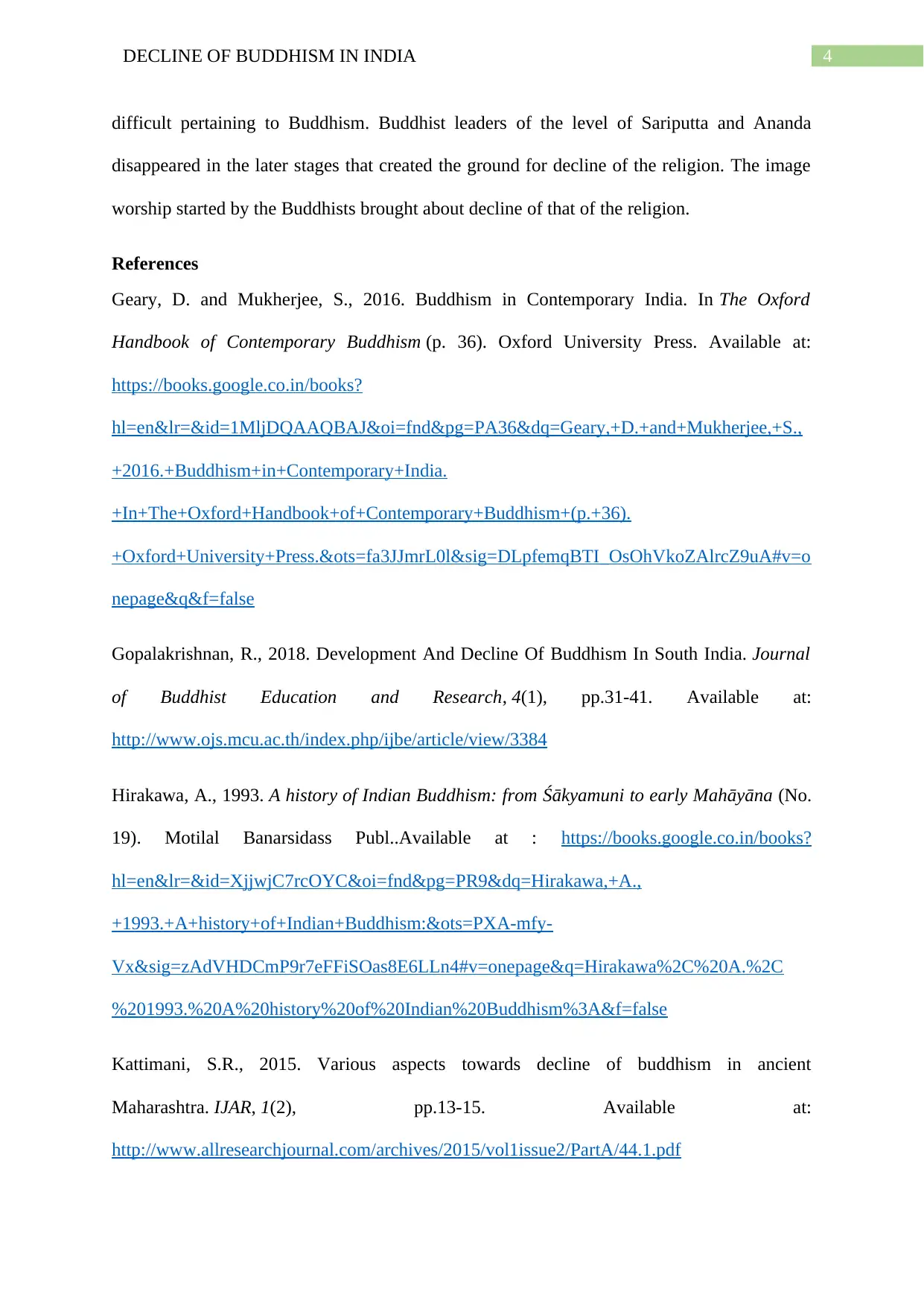
4DECLINE OF BUDDHISM IN INDIA
difficult pertaining to Buddhism. Buddhist leaders of the level of Sariputta and Ananda
disappeared in the later stages that created the ground for decline of the religion. The image
worship started by the Buddhists brought about decline of that of the religion.
References
Geary, D. and Mukherjee, S., 2016. Buddhism in Contemporary India. In The Oxford
Handbook of Contemporary Buddhism (p. 36). Oxford University Press. Available at:
https://books.google.co.in/books?
hl=en&lr=&id=1MljDQAAQBAJ&oi=fnd&pg=PA36&dq=Geary,+D.+and+Mukherjee,+S.,
+2016.+Buddhism+in+Contemporary+India.
+In+The+Oxford+Handbook+of+Contemporary+Buddhism+(p.+36).
+Oxford+University+Press.&ots=fa3JJmrL0l&sig=DLpfemqBTI_OsOhVkoZAlrcZ9uA#v=o
nepage&q&f=false
Gopalakrishnan, R., 2018. Development And Decline Of Buddhism In South India. Journal
of Buddhist Education and Research, 4(1), pp.31-41. Available at:
http://www.ojs.mcu.ac.th/index.php/ijbe/article/view/3384
Hirakawa, A., 1993. A history of Indian Buddhism: from Śākyamuni to early Mahāyāna (No.
19). Motilal Banarsidass Publ..Available at : https://books.google.co.in/books?
hl=en&lr=&id=XjjwjC7rcOYC&oi=fnd&pg=PR9&dq=Hirakawa,+A.,
+1993.+A+history+of+Indian+Buddhism:&ots=PXA-mfy-
Vx&sig=zAdVHDCmP9r7eFFiSOas8E6LLn4#v=onepage&q=Hirakawa%2C%20A.%2C
%201993.%20A%20history%20of%20Indian%20Buddhism%3A&f=false
Kattimani, S.R., 2015. Various aspects towards decline of buddhism in ancient
Maharashtra. IJAR, 1(2), pp.13-15. Available at:
http://www.allresearchjournal.com/archives/2015/vol1issue2/PartA/44.1.pdf
difficult pertaining to Buddhism. Buddhist leaders of the level of Sariputta and Ananda
disappeared in the later stages that created the ground for decline of the religion. The image
worship started by the Buddhists brought about decline of that of the religion.
References
Geary, D. and Mukherjee, S., 2016. Buddhism in Contemporary India. In The Oxford
Handbook of Contemporary Buddhism (p. 36). Oxford University Press. Available at:
https://books.google.co.in/books?
hl=en&lr=&id=1MljDQAAQBAJ&oi=fnd&pg=PA36&dq=Geary,+D.+and+Mukherjee,+S.,
+2016.+Buddhism+in+Contemporary+India.
+In+The+Oxford+Handbook+of+Contemporary+Buddhism+(p.+36).
+Oxford+University+Press.&ots=fa3JJmrL0l&sig=DLpfemqBTI_OsOhVkoZAlrcZ9uA#v=o
nepage&q&f=false
Gopalakrishnan, R., 2018. Development And Decline Of Buddhism In South India. Journal
of Buddhist Education and Research, 4(1), pp.31-41. Available at:
http://www.ojs.mcu.ac.th/index.php/ijbe/article/view/3384
Hirakawa, A., 1993. A history of Indian Buddhism: from Śākyamuni to early Mahāyāna (No.
19). Motilal Banarsidass Publ..Available at : https://books.google.co.in/books?
hl=en&lr=&id=XjjwjC7rcOYC&oi=fnd&pg=PR9&dq=Hirakawa,+A.,
+1993.+A+history+of+Indian+Buddhism:&ots=PXA-mfy-
Vx&sig=zAdVHDCmP9r7eFFiSOas8E6LLn4#v=onepage&q=Hirakawa%2C%20A.%2C
%201993.%20A%20history%20of%20Indian%20Buddhism%3A&f=false
Kattimani, S.R., 2015. Various aspects towards decline of buddhism in ancient
Maharashtra. IJAR, 1(2), pp.13-15. Available at:
http://www.allresearchjournal.com/archives/2015/vol1issue2/PartA/44.1.pdf
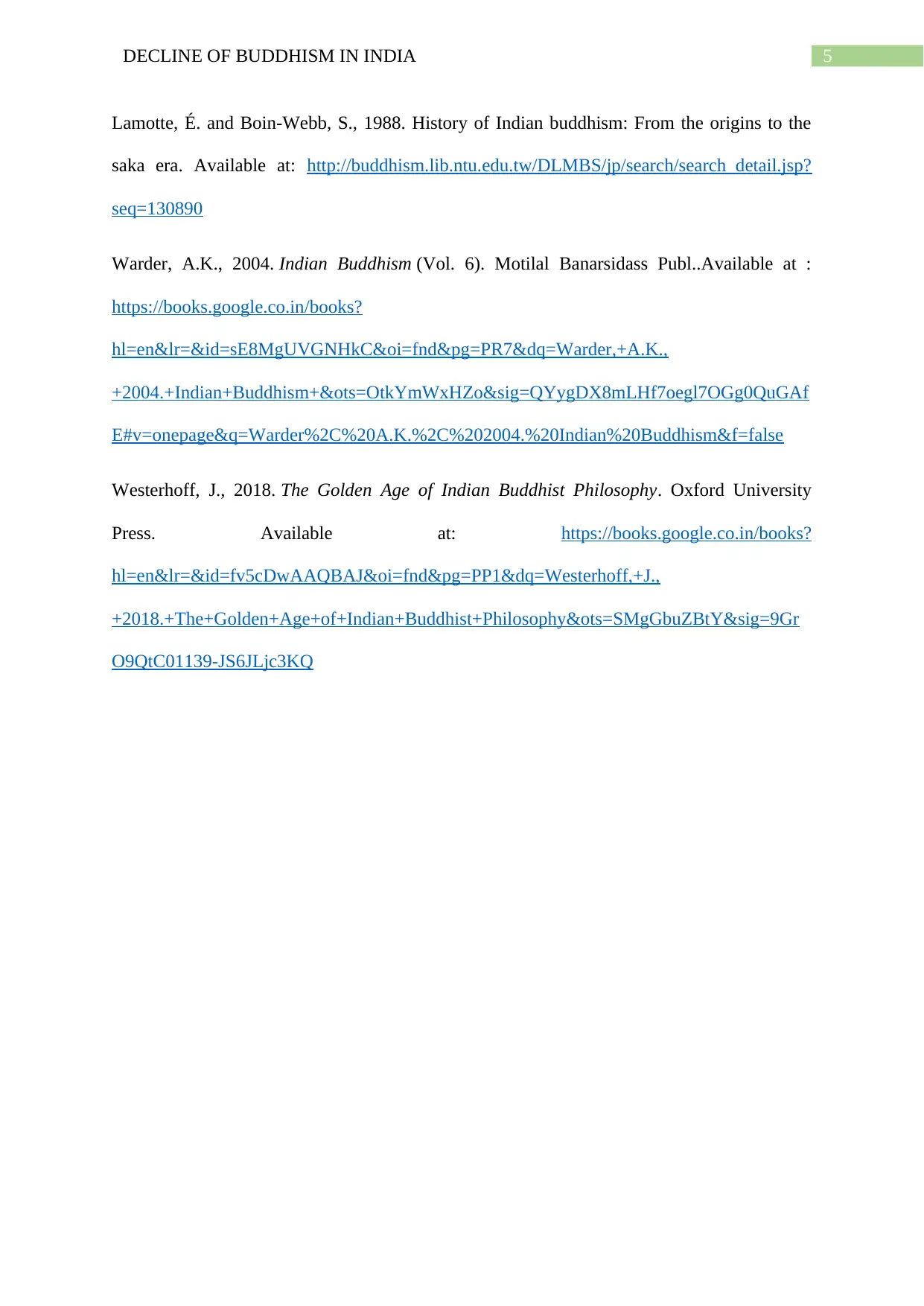
5DECLINE OF BUDDHISM IN INDIA
Lamotte, É. and Boin-Webb, S., 1988. History of Indian buddhism: From the origins to the
saka era. Available at: http://buddhism.lib.ntu.edu.tw/DLMBS/jp/search/search_detail.jsp?
seq=130890
Warder, A.K., 2004. Indian Buddhism (Vol. 6). Motilal Banarsidass Publ..Available at :
https://books.google.co.in/books?
hl=en&lr=&id=sE8MgUVGNHkC&oi=fnd&pg=PR7&dq=Warder,+A.K.,
+2004.+Indian+Buddhism+&ots=OtkYmWxHZo&sig=QYygDX8mLHf7oegl7OGg0QuGAf
E#v=onepage&q=Warder%2C%20A.K.%2C%202004.%20Indian%20Buddhism&f=false
Westerhoff, J., 2018. The Golden Age of Indian Buddhist Philosophy. Oxford University
Press. Available at: https://books.google.co.in/books?
hl=en&lr=&id=fv5cDwAAQBAJ&oi=fnd&pg=PP1&dq=Westerhoff,+J.,
+2018.+The+Golden+Age+of+Indian+Buddhist+Philosophy&ots=SMgGbuZBtY&sig=9Gr
O9QtC01139-JS6JLjc3KQ
Lamotte, É. and Boin-Webb, S., 1988. History of Indian buddhism: From the origins to the
saka era. Available at: http://buddhism.lib.ntu.edu.tw/DLMBS/jp/search/search_detail.jsp?
seq=130890
Warder, A.K., 2004. Indian Buddhism (Vol. 6). Motilal Banarsidass Publ..Available at :
https://books.google.co.in/books?
hl=en&lr=&id=sE8MgUVGNHkC&oi=fnd&pg=PR7&dq=Warder,+A.K.,
+2004.+Indian+Buddhism+&ots=OtkYmWxHZo&sig=QYygDX8mLHf7oegl7OGg0QuGAf
E#v=onepage&q=Warder%2C%20A.K.%2C%202004.%20Indian%20Buddhism&f=false
Westerhoff, J., 2018. The Golden Age of Indian Buddhist Philosophy. Oxford University
Press. Available at: https://books.google.co.in/books?
hl=en&lr=&id=fv5cDwAAQBAJ&oi=fnd&pg=PP1&dq=Westerhoff,+J.,
+2018.+The+Golden+Age+of+Indian+Buddhist+Philosophy&ots=SMgGbuZBtY&sig=9Gr
O9QtC01139-JS6JLjc3KQ
⊘ This is a preview!⊘
Do you want full access?
Subscribe today to unlock all pages.

Trusted by 1+ million students worldwide
1 out of 6
Your All-in-One AI-Powered Toolkit for Academic Success.
+13062052269
info@desklib.com
Available 24*7 on WhatsApp / Email
![[object Object]](/_next/static/media/star-bottom.7253800d.svg)
Unlock your academic potential
Copyright © 2020–2025 A2Z Services. All Rights Reserved. Developed and managed by ZUCOL.

